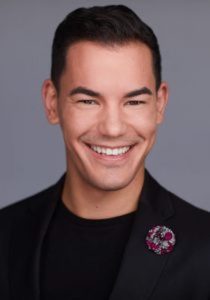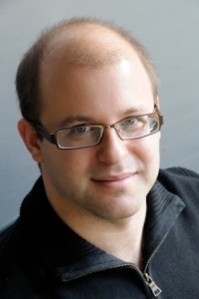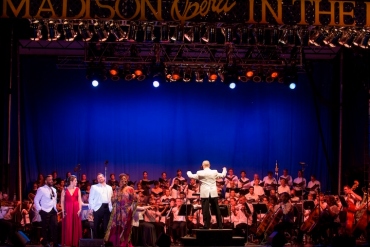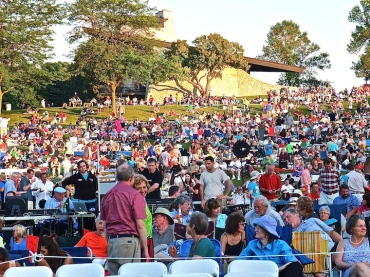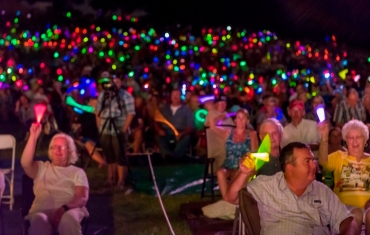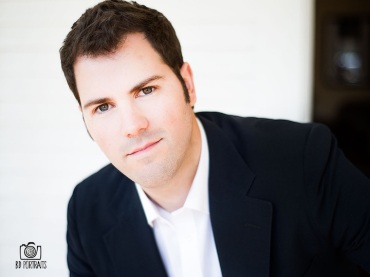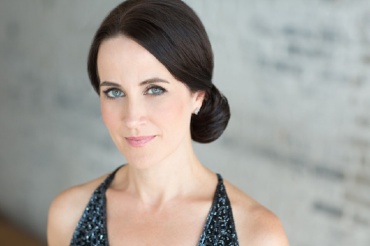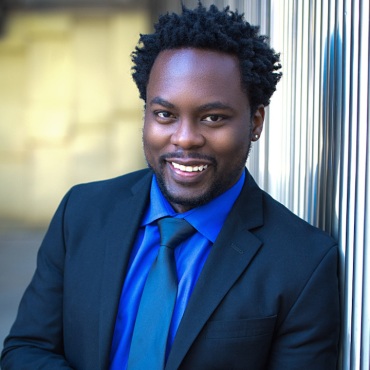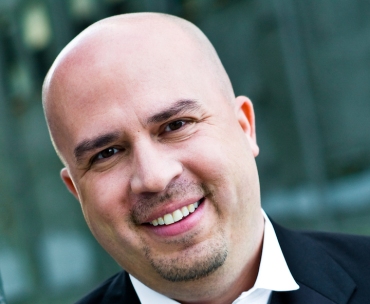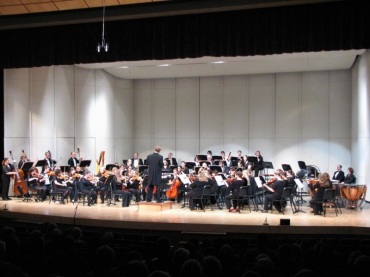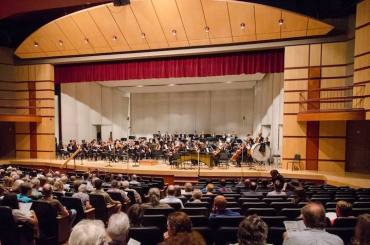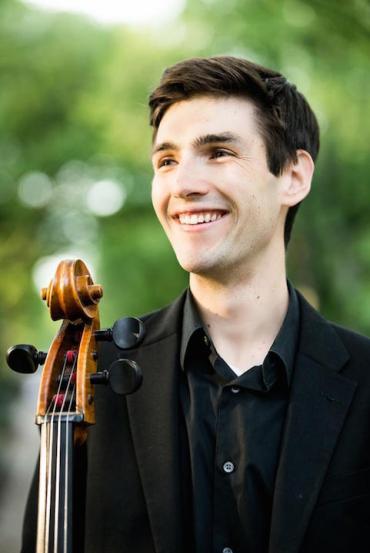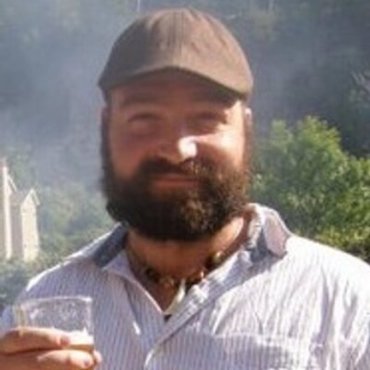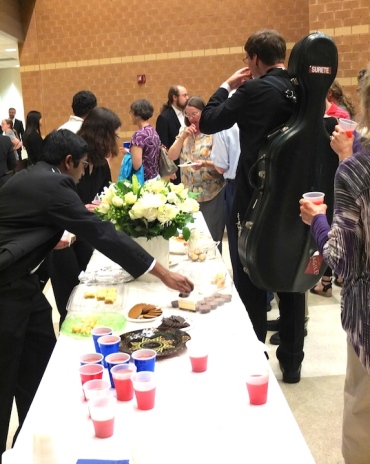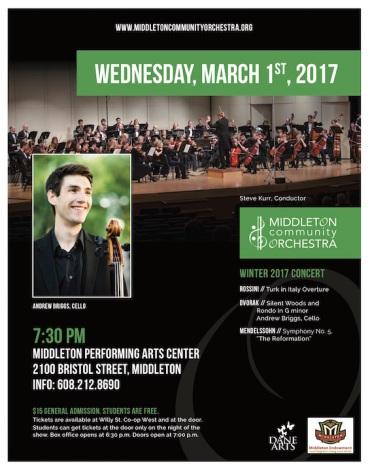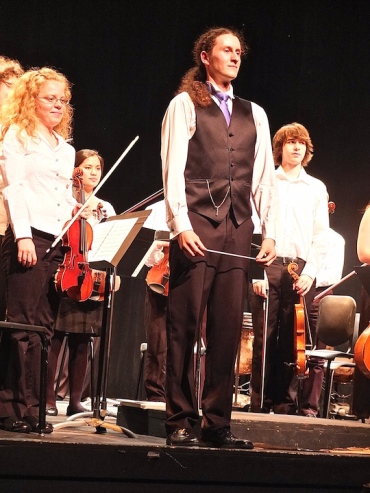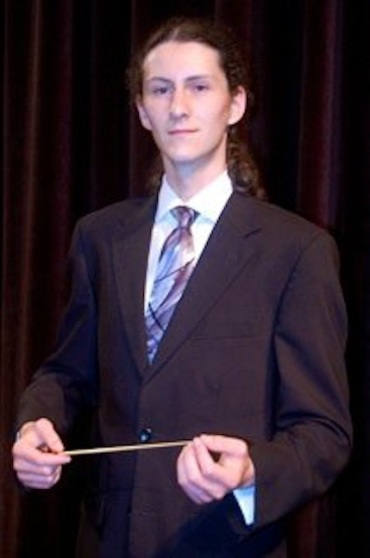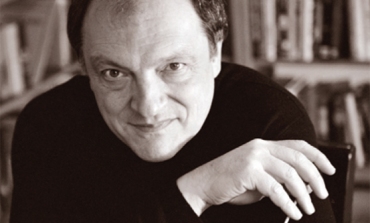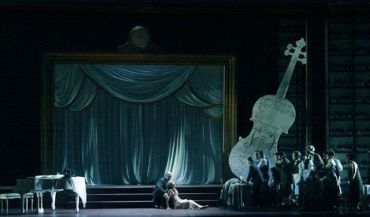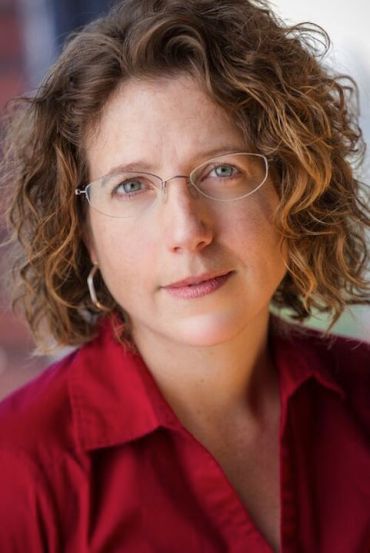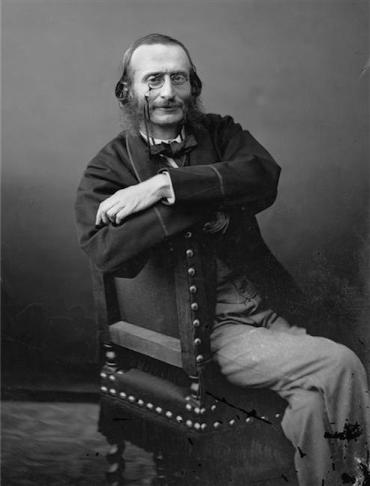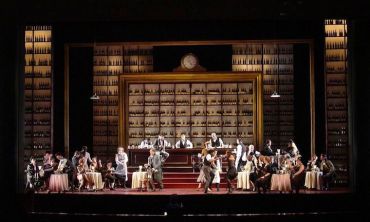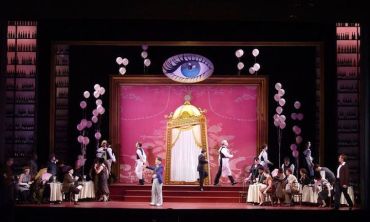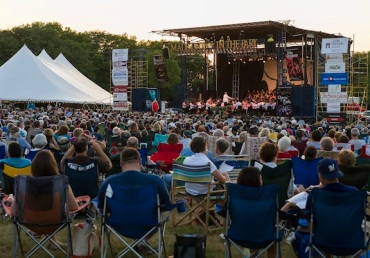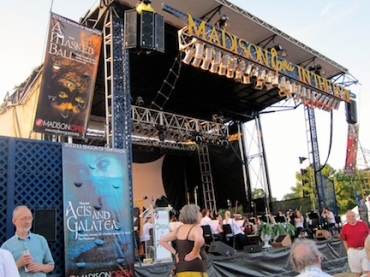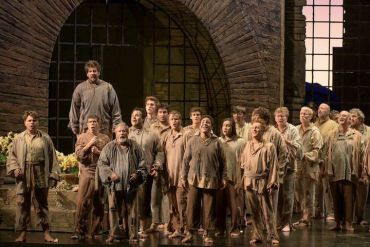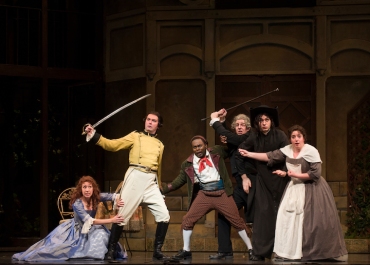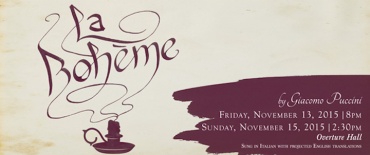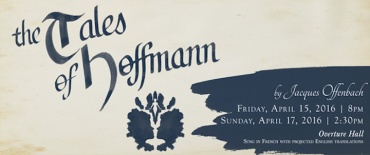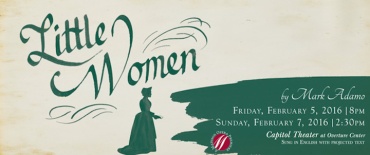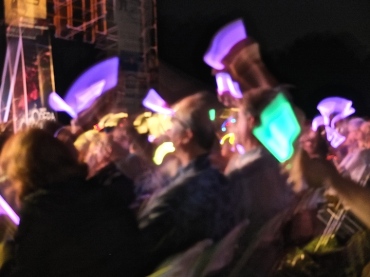The Well-Tempered Ear
Wisconsin Youth Symphony Orchestras (WYSO) will build a new $25 million home on East Washington Avenue
1 Comment
PLEASE HELP THE EAR. IF YOU LIKE A CERTAIN BLOG POST, SPREAD THE WORD. FORWARD A LINK TO IT OR, SHARE IT or TAG IT (not just “Like” it) ON FACEBOOK. Performers can use the extra exposure to draw potential audience members to an event. And you might even attract new readers and subscribers to the blog.
By Jacob Stockinger
The Ear has received the following major announcement to post:
The Wisconsin Youth Symphony Orchestras (WYSO) has announced plans to construct a new $25 million-building in the 1100 block of East Washington Avenue in Madison, Wisconsin.
The new home will occupy three lots and will replace the historic Avenue Bar (below)
The new music center will continue WYSO’s vision to expand instrumental music education and performance opportunities for young people of diverse backgrounds and inspire excellence and a lifelong connection to music.
More than 500 young musicians from communities throughout southern Wisconsin currently participate in WYSO’s programs.
This 500 percent growth in student numbers since the organization’s founding is driving the need for facilities large enough to support both the organization’s programs and its mission of providing transformational musical experiences and opportunities.
For more information about WYSO, go to its home website: https://wysomusic.org
The purchase of the property and the kick-off of WYSO’s capital campaign have been made possible by two lead gifts totaling $18 million from Pleasant Rowland and Jerry Frautschi, who have long been supporters of the organization.
The planned 40,000 sq. ft- building will provide state-of-the-art rehearsal spaces sized for full orchestras; a room designed for percussion including a world-class array of percussion instruments; rehearsal rooms perfect for ensembles and chamber music; a piano laboratory; and small teaching studios for private lessons.
The building will also hold all of WYSO’s current orchestra and Music Makers programs, administrative offices, a music library— and provide opportunity to grow.
But the building will NOT contain public performance spaces. WYSO will continue to rent and use venues that already exist.
Since the fall of 2020, the organization – which used to be located in the UW-Madison School of Music — has been without a home base and has pieced out its program in different facilities throughout the Madison area. (In the YouTube video at the bottom, you can hear the WYSO Youth Orchestra give a virtual and socially distanced performance last year of the finale of Rossini’s Overture to “William Tell.”)
This new building will allow all of WYSO’s programs to thrive under a single roof and provide the space, location, resources and connections necessary for WYSO to become a key collaborator in a growing youth arts community.
WYSO’s new home will be around the corner from the newly constructed Madison Youth Arts (My Arts), creating a vibrant youth arts synergy on the near east side. (An architect’s renderings of the exterior and interior theater are below.)
Located on a major transit corridor for easy access with adequate parking, the building will be in proximity to area performing arts venues, with space for WYSO’s programs and community events.
Says WYSO’s Executive Director Bridget Fraser: “Thanks to the incredible generosity of Pleasant Rowland and Jerry Frautschi, musicians of all ages will have state-of-the-art rehearsal facilities to call home. It’s a dream come true!”
WYSO has partnered with Urban Assets, city planners with experience in real estate development; Strang, an integrated architecture, engineering, interior design and planning firm with a history of designing for the civic and cultural sectors; Talaske Sound, experts in architectural acoustics; and J.H. Findorff & Son, a local construction firm passionate about youth education and the arts.
Tags: #AvenueBar, #BlogPost, #BlogPosting, #BridgetFraser, #CapitalCampaign, #ChamberMusic, #CityPlanner, #CoronavirusPandemic, #EastWashingtonAvenue, #ExecutiveDirector, #FacebookPost, #FacebookPosting, #GioachinoRossini, #HomeWebsite, #InteriorDesign, #J.H.Findorff, #J.H.Findorff&Son, #JacobStockinger, #JerryFrautschi, #KyleKnox, #LastYear, #MadisonYouthArts, #MeadWitterSchoolofMusic, #MusicCenter, #MusicDirector, #MusicEducation, #MusicLibrary, #MusicMakers, #OperaOverture, #PleasantRowland, #PrivateLesson, #RealEstate, #SocialDistance, #TalaskeSound, #TheEar, #TheUW, #UniversityofWisconsin-Madison, #UrbanAssets, #VirtualConcert, #WilliamTell, #WilliamTellOverture, #WisconsinYouthSymphonyOrchestras, #WYSOconcerts, #YoungPeople, #YouthOrchestra, #YouTubevideo, achitecture, acoustics, adequate, administrative, architect, area, Arts, audience, Avenue Bar, bar, blog, Bridget Fraser, build, building, capital campaign, Cello, center, Chamber music, city planner, civic, Classical music, collaborator, community, Concert, connection, construction, contain, coronavirus, coronavirus pandemic, corridor, cultural, development, diverse, diversity, dream, East Washington Avenue, Education, engineering, ensemble, exapnd, Executive director, exist, experience, expert, exterior, Facebook, Facebook post, Facebook posting, facilities, firm, forward, founding, Fraser, gift, Gioachino Rossini, grow, growth, historic, Home, information, instrument, interior, interior design, J.H. Findorff & Son, Jacob Stockinger, Jerry Frautschi, key, kick off, Kyle Knox, Laboratory, large, last, last year, lessons, library, like, link, local, located, lots, Madison, Madison Youth Arts, major, Mead Witter School of Music, million, mission, Music, music center, Music director, Music education, music library, Music Makers, need, new, numbers, office, opera, opportunity, Orchestra, organization, Overture, pandemic, parking, partner, passionate, percussion, performance, Piano, plan, Pleasant Rowland, possible, post, posting, private lesson, program, property, public, purchase, real estate, rehearsal, rendering, Rent, replace, resources, restaurant, rooms, Rossini, sector, share, size, small, social distance, son, space, state-of-the-art, Strang, students, studio, support, supporter, symphony, synergy, tag, Talaske Sound, teaching, The Ear, theater, transformation, transit, true, United States, University of Wisconsin-Madison School of Music, University of Wisconsin–Madison, Urban Assets, use, UW, UW-Madison, venue, vibrant, Viola, Violin, virtual, vision, Washington, Website, William Tell, Wisconsin, Wisconsin Youth Symphony Orchestras, world-class, WYSO, year, young, young people, Youth, Youth Orchestra, YouTube, YouTube video
The UW Symphony Orchestra performs a FREE online concert Thursday night and Friday night the Wisconsin Chamber Orchestra debuts its second chamber music concert. But in-person micro-concerts on Sunday by the the Willy Street Chamber Players are sold-out
Leave a Comment
PLEASE HELP THE EAR. IF YOU LIKE A CERTAIN BLOG POST, SPREAD THE WORD. FORWARD A LINK TO IT OR, SHARE IT or TAG IT (not just “Like” it) ON FACEBOOK. Performers can use the extra exposure to draw potential audience members to an event. And you might even attract new readers and subscribers to the blog.
By Jacob Stockinger
The second half of the music season is well under way, with just about every major group performing online – or in one case even in person.
Here are three selections this week:
THURSDAY
Two of the most musically and technically impressive concerts The Ear heard last semester took place at the UW-Madison’s Mead Witter School of Music. They were by the UW-Madison Symphony Orchestra under the direction of conductor Oriol Sans (below).
First, Sans conducted a socially distanced and virtual all-strings concert (below).
Then, for the second concert, the conductor had the winds and brass – which spray dangerous aerosol droplets – record their parts individually. Then for the live performance, Sans donned earphones and masterfully combined all the forces into a full orchestra performance (below).
You can see similar results – with percussion joining for the strings for the last piece — this Thursday night, Feb. 25, at 7:30 p.m. on YouTube when the UW Symphony Orchestra live-streams a 90-muinute concert from the Mead Witter Foundation Concert Hall in the Hamel Music Center. No in-person attendance is allowed.
Here is the program:
I Crisantemi (Chyrsanthemums) by Italian opera composer Giacomo Puccini (1858-1924), with Michael Dolan, guest conductor
“Leyendas: An Andean Walkabout” by contemporary American composer Gabriela Lena Frank (b. 1972) Coqueteos (Flirtations)
“Carmen” Suite (after the opera by Georges Bizet) by Russian composer Rodion Shchedrin (b.1932): Introduction; Dance; Carmen’s entrance and Habanera Torero; Adagio; Fortune-telling; and Finale.
Here is a link to the live-streamed video: https://youtu.be/GSrMLKrjlVg
And here is a link to more information, including program notes and the names of members of the orchestra: https://www.music.wisc.edu/event/uw-madison-symphony-orchestra-2/
FRIDAY NIGHT
On Friday night at 7:30 p.m. the Wisconsin Chamber Orchestra (below, in a photo by Mike Gorski) will offer the second of its Winter Chamber Series. It will run between 60 and 75 minutes.
There will be string, brass and percussion music by Mozart, Beethoven, Rossini, Steve Reich, Craig H. Russell and Thomas Siwe. Be aware that three of the works – string quartets by Mozart and Beethoven and a string sonata by Rossini — are presented in excerpts. That is not listed on the webpage.
The cost for one-time access between Friday night and Monday night is $30.
Here is a link to more information, including a link to ticket sales from the Overture Center box office and program notes by WCO music director and conductor Andrew Sewell (below, in a photo by Alex Cruz): https://wcoconcerts.org/events/winter-chamber-series-no-ii
SOLD-OUT
The Micro-concerts scheduled for this coming Sunday, Feb. 28, by the esteemed Willy Street Chamber Players (below), are SOLD-OUT.
The 10-minute private concerts for two, which require masks and social distancing for all, are perhaps the most innovative move by any local music group during the coronavirus pandemic.
The Ear, who expects concert habits to change after the pandemic, thinks such micro-concerts have a very bright future even after the pandemic is under control and audiences can return safely to mass events.
The concert are pay-what-you can but a $20 donation for two was suggested.
For more information about the micro-concerts, listen to the YouTube video at the bottom and go to: http://www.willystreetchamberplayers.org/micro-concerts.html
Tags: #AndesMountains, #AndrewSewell, #BlogPost, #BlogPosting, #BoxOffice, #BrassMusic, #ChamberMusic, #Chrysanthemums, #CoronavirusPandemic, #CraigH.Russell, #FacebookPost, #FacebookPosting, #GabrielaLenaFrank, #GeorgesBizet, #GiacomoPuccini, #GioachinoRossini, #HamelMusicCenter, #HomeWebsite, #italianComposer, #JacobStockinger, #LiveStreaming, #LudwigVanBeethoven, #MeadWitterSchoolofMusic, #MusicDirector, #OnlineConcert, #OperaMusic, #OriolSans, #OvertureCenter, #ProgramNotes, #PublicSafety, #RecordedMusic, #RodionShchedrin, #RussianComposer, #SocialDistance, #SocialDistancing, #SteveReich, #StringMusic, #StringQuartet, #SundayAfternoonLifeFromtheChazen, #TheEar, #TheUW, #TheWillys, #ThomasSiwe, #UniversityofWisconsin-Madison, #UWSymphonyOrchestra, #VirtualConcert, #WebPage, #WillyStreetChamberPlayers, #WindMusic, #WinterChamberMusicSeries, #WinterChamberSeries, #WisconsinChamberOrchestra, #WolfgangAmadeusMozart, #YouTubeChannel, #YouTubevideo, access, aerosol, allow, American, Andes, Andrew Sewell, Arts, attendance, audience, Beethoven, Bizet, blog, Blog post, blog posting, bog, box office, brass, brass music, bright, buy, Carmen, cellist, Cello, Chamber music, change, Classical music, classicalmusic, combine, composer, Concert, conductor, control, coronavirus, Craig H. Russell, dance, dangerous, direction, donation, droplet, earphones, excerpts, expect, Facebook, Facebook post, Facebook posting, force, fortune-teller, forward, free, Friday, future, Gabriela Lena Frank, Georges Bizet, Giacomo Puccini, Gioachino Rossini, group, habits, Hamel Music Center, home website, impressive, in person, individual, information, innovative, instrumental, introduction, Italian, Italy, Jacob Stockinger, like, link, livestream, Livestreamed, local, Ludwig van Beethoven, Madison, masks, masterful, masterfully, Mead Witter Foundation Concert Hall, Mead Witter School of Music, member, micro-concert, Monday, Mozart, Music, Music director, musical, name, night, notes, online, opera, Orchestra, orchestral music, Oriol Sans, Overture Center, pandemic, part, percussion, performer, perhaps, post, posting, private, program, program notes, public safety, Puccini, record, recorded music, Reich, Rodion Shchedrin, Rossini, run, Russell, Russia, Russian, safe, safely, sales, schedule, scheduled, Season, semester, Sewell, share, Siwe, social distance, sold-out, Sonata, spray, Steve Reich, string music, String quartet, strings, Suite, Sunday, symphony, tag, technical, The Ear, The Willys, Thomas Siwe, Thursday, ticket, United States, University of Wisconsin-Madison School of Music, University of Wisconsin–Madison, UW, UW Symphony Orchestra, UW-Madison, video, Viola, Violin, violinist, violist, virtual, WCO, web page, Willy Street Chamber Players, wind music, winds, winter, Winter Chamber Music Series, Winter Chamber Series, Wisconsin, Wisconsin Chamber Orchestra, Wolfgang Amadeus Mozart, YouTube, YouTube video
Classical music: Here is the complete concert program for the Madison Opera’s Digital Opera in the Park. It premieres online TONIGHT at 8 and stays up until Aug. 25
Leave a Comment
PLEASE HELP THE EAR. IF YOU LIKE A CERTAIN BLOG POST, SPREAD THE WORD. FORWARD A LINK TO IT OR, SHARE IT or TAG IT (not just “Like” it) ON FACEBOOK. Performers can use the extra exposure to draw potential audience members to an event. And you might even attract new readers and subscribers to the blog.
By Jacob Stockinger
The 2020 edition of the Madison Opera’s annual summer event Opera in the Park (below, a photo from the past) will be virtual and online due the coronavirus pandemic and the COVID-19 public health crisis.
The concert – which can be viewed indoors or outdoors, anywhere in the country or the world — begins at 8 p.m. CDT TONIGHT, Saturday, July 25. It will remain available online until Aug. 25.
Here are links to the portals where you can watch and listen to the opera program and also join the post-concert Q&A with performers: https://www.madisonopera.org and https://vimeo.com/437164679
For more information about the 90-minute concert, and related events, as well as the performers and the donors, go to: https://welltempered.wordpress.com/2020/07/23/classical-music-madison-operas-virtual-opera-in-the-park-goes-online-for-free-this-saturday-night-and-stay-up-until-aug-25-listen-to-it-indoors-or-outdoors-to-enhance-the-experience/
HERE IS THE COMPLETE PROGRAM FOR THE EVENING
Overture | The Marriage of Figaro (W.A. Mozart; 1786)
Suzanne Beia, violin; John DeMain (below) and Scott Gendel, piano
“Quel guardo, il cavaliere” | Don Pasquale (Gaetano Donizetti; 1843)
Jasmine Habersham, soprano (below); Rolando Salazar, piano
“Un’aura amorosa” | Così fan tutte (W.A. Mozart; 1789)
Andres Acosta, tenor (below); Marika Yasuda, piano
“Ernani, involami” | Ernani (Giuseppe Verdi; 1844)
Karen Slack, soprano (below); Laura Ward, piano
“Vision fugitive” | Hérodiade (Jules Massenet; 1881)
Weston Hurt, baritone (below); Bethany Self, piano
“Aber der Richtige” | Arabella (Richard Strauss; 1933)
Jasmine Habersham, soprano; Karen Slack, soprano; Scott Gendel, piano (below)
“Au fond du temple saint” | The Pearl Fishers (Georges Bizet; 1863)
Andres Acosta, tenor; Weston Hurt, baritone; Scott Gendel, piano
“Deh vieni, non tardar” | The Marriage of Figaro (W.A. Mozart; 1786)
Jasmine Habersham, soprano; Rolando Salazar, piano
“Il balen del suo sorriso” | Il Trovatore (Giuseppe Verdi; 1853)
Weston Hurt, baritone; Bethany Self, piano
“Anvil Chorus” | Il Trovatore (Giuseppe Verdi; 1853)
Madison Opera Chorus via Zoom (below); Anthony Cao, conductor and piano
“Vissi d’arte” | Tosca (Giacomo Puccini; 1900)
Karen Slack, soprano; Laura Ward, piano
“Asile héréditaire” | William Tell (Gioachino Rossini; 1829)
Andres Acosta, tenor; Marika Yasuda, piano
“Meditation” | Thaïs (Jules Massenet; 1894)
Suzanne Beia, violin (below); John DeMain, piano
Spiritual “Scandalize My Name” | arranged by Johnnie Dean
Jasmine Habersham, soprano; Karen Slack, soprano; Scott Gendel, piano
“No puede ser” | La Tabernera del Puerto (Pablo Sorozabal; 1936)
Andres Acosta, tenor; Marika Yasuda, piano
“Vanilla Ice Cream” | She Loves Me (Jerry Bock; 1963)
Jasmine Habersham, soprano; Rolando Salazar, piano
“Some Enchanted Evening” | South Pacific (Richard Rodgers; 1949)
Weston Hurt, baritone; Bethany Self, piano
“He’s Got the Whole World in His Hands” | arranged by Margaret Bonds
Karen Slack, soprano; Laura Ward, piano
SING-ALONG FINALE: It’s a Grand Night for Singing | State Fair (Richard Rodgers; 1945)
Tags: #AfircanAmerican, #African-AmericanMusic, #AfricanAmerican, #AndresAcosta, #AnthonyCao, #AnvilChorus, #BaritoneSinger, #BethanySelf, #BlogPost, #BlogPosting, #BroadwayMusical, #CentralDaylightTime, #ChoralMusic, #CoronavirusPandemic, #CosifanTutte, #COVID-19, #DigitalMedia, #DigitalOperainthePark, #DonPasquale, #DuetMusic, #FacebookPost, #FacebookPosting, #GaetanoDonizetti, #GeorgesBizet, #GiacomoPuccini, #GioachinoRossini, #GiuseppeVerdi, #HesGottheWholeWorldinHisHands, #IceCream, #IlTrovatore, #It'saGrandNightforSinging, #JasmineHabersham, #JerryBock, #JohnDeMain, #JulesMassenet, #KarenSlack, #LaTaberneradelPuerto, #LauraWard, #MadisonOpera, #MadisonOperaChorus, #MarikaYasuda, #MarriageofFigaro, #NegroSpiritual, #OperaAria, #OperaArias, #OperaInThePark, #OperaMusic, #PabloSarozabal, #PianoAccompaniment, #PianoAccompanist, #PublicHealth, #RelatedEvent, #RichardRodgers, #RodgersandHammerstein, #RolandoSalazar, #ScottGendel, #SheLoveMe, #SomeEnchantedEvening, #SopranoSinger, #SouthPacific, #StateFair, #SuzanneBeia, #TenorSinger, #TheEar, #ThePearlFishers, #VanillaIceCream, #VisionFugitive, #VocalMusic, #WestonHurt, #WilliamTell, #WolfgangAmadeusMozart, accompanist, accompany, accompanying, African American, Andres Acosta, annual, Anthony Cao, Anvil Chorus, aria, audience, available, baritone, begin, Bethany Self, Bizet, black, blog, Broadway, Broadway musical, CDT, Central Daylight Time, choral music, Concert, conductor, coronavirus, Cosi fan tutte, crisis, cuntry, Digital Opera in the Park, Don Pasquale, Donizetti, donor, duet, edition, Ernani, evening, event, Facebook, finale, forward, fugitive, Gaetano Donizetti, Georges Bizet, Giacomo Puccini, Gioachino Rossini, Giuseppe Verdi, He's Got the Whole World in His Hands, ice cream, Il Trovatore, indoors, information, It's a Grand Night for Singing, Jasmine Habersham, Jerry Bock, John DeMain, Jules Massenet, Karen Slack, La Tabernera del Puerto, Laura Ward, like, link, Love, Madison Opera, Madison Opera Chorus, Marika Yasuda, Marriage of Figaro, Massenet, me, Meditation, minute, Mozart, musical, night, online, opera, Opera in the Park, opera music, outdoors, Overture, Pablo Sarozabal, pandemic, Pianist, Piano, portal, post, post-concert, posting, premiere, program, Public health, Puccini, Q&A, related event, Richard Rodgers, Rodgers, Rodgers and Hammerstein, Rolando Salazar, Rossini, scandalize, Scott Gendel, share, she, She Loves Me, sing-along, singer, Some Enchanted Evening, soprano, South Pacific, spiritual, State Fair, summer, Suzanne Beia, tag, tenor, Thaïs, The Ear, The Marriage of Figaro, The Pearl Fishers, tonight, Tosca, vanilla, Verdi, view, Violin, violinist, virtual, vision, vision fugitive, vocal music, Website, Weston Hurt, William Tell, Wolfgang Amadeus Mozart, world, Zoom
Classical music: Two Madison pianists perform four-hand American music Monday night at a concert for the Rural Musicians Forum at Taliesin in Spring Green
3 Comments
IF YOU LIKE A CERTAIN BLOG POST, PLEASE SPREAD THE WORD. FORWARD A LINK TO IT OR, SHARE IT or TAG IT (not just “Like” it) ON FACEBOOK. Performers can use the extra exposure to draw potential audience members to an event. And you might even attract new readers and subscribers to the blog.
By Jacob Stockinger
For the first time ever, the Rural Musicians Forum will present music for piano 4-hands, where two pianists play simultaneously on one piano.
On this coming Monday, July 22, at 7:30 p.m. in the Hillside Theater at architect Frank Lloyd Wright’s Taliesin compound in Spring Green, Madison-based pianists Satoko Hayami (below top) and Jason Kutz (below bottom) will showcase four-hand piano music by American composers, spanning from 1864 to 2019.
The concert by the two graduate students at the University of Wisconsin-Madison’s Mead Witter School of Music will present a variety of composers and works created for this ensemble: pre-ragtime composer Louis Moreau Gottschalk’s virtuosic arrangement of Gioachino Rossini’s William Tell Overture; excerpts from Samuel Barber’s Souvenirs, a ballet suite (heard played tag-team style in the YouTube video below); a lush arrangement of themes from the Wizard of Oz by William Hirtz; and the riveting Gazebo Dances by John Corigliano, a four-movement work that, in his own words, suggests “the pavilions often seen on village greens in towns throughout the countryside, where public band concerts are given on summer evenings.”
Additionally, the audience will hear the world premiere arrangement of Music in 3/4 for Four by Kutz, excerpts from his solo piano suite, Music in 3/4.
Admission is by free will offering, with a suggested donation of $15.
Taliesin’s Hillside Theater (below) is located at 6604 State Highway 23, about five miles south of Spring Green.
Tags: #AmericanComposer, #AmericanMusic, #balletsuite, #BandConcert, #BlogPost, #BlogPosting, #ChamberMusic, #ChamberMusicians, #ClassicalMusician, #FacebookPost, #FacebookPosting, #FrankLloydWright, #FreewillOffering, #GazeboDances, #GioachinoRossini, #GraduateStudent, #HillsideTheater, #JasonKutz, #JohnCorigliano, #LouisMoreauGottschalk, #MeadWitterSchoolofMusic, #PianoMusic, #RagtimeMusic, #RuralMusiciansForum, #SamuelBarber, #SatokoHayami, #SoloPiano, #SoloPianoMusic, #SpringGreen, #StateHighway, #Taliesincompound, #UniversityofWisconsin-Madison, #WilliamHirtz, #WilliamTell, #WilliamTellOverture, #WizardofOz, #WorldPremiere, #YouTubevideo, American, architect, arrangement, Arts, audience, ballet, ballet suite, band concert, blog, Chamber music, Classical music, classicalmusic, composer, composers, Concert, countryside, donation, ensemble, Ensemble Musical Offering, evening, event, excerpts, Facebook, forum, four-hand, Frank Lloyd Wright, freewill, gazebo, Gazebo Dances, Gioacchino Rossini, Gioachino Rossini, graduate student, greens, Hillside Theater, Jacob Stockinger, Jazon Kutz, John Corigliano, like, link, Louis Moreau Gottschalk, lush, Madison, Mead Witter School of Music, movement, Music, Musician, offering, Overture, pavilion, perform, performer, Pianist, Piano, piano music, public, Ragtime, reader, Rossini, rural, Rural Musicians Forum, Samuel Barber, Satoko Hayami, setting, share, showcase, simultaneously, solo, souvenir, Souvenirs, Spring Green, state highway, Student, style, subscriber, Suite, summer, tag, tag-team, Taliesin, theme, towns, unique, United States, University of Wisconsin-Madison School of Music, University of Wisconsin–Madison, UW-Madison, variety, village, virtuosic, William Hirtz, William Tell, William Tell Overture, Wisconsin, Wizard of Oz, words, works, world premiere, YouTube
Classical music: The Middleton Community Orchestra reveals a leaner Sibelius and violin soloist Tim Kamps proves masterful in a rarely heard concerto by Alexander Glazunov
Leave a Comment
CORRECTION: The performances by the Madison Symphony Chorus that were incorrectly listed for this coming Sunday in yesterday’s post took place last Sunday. The Ear apologizes and regrets the error.
By Jacob Stockinger
Here is a special posting, a review written by frequent guest critic and writer for this blog, John W. Barker. Barker (below) is an emeritus professor of Medieval history at the University of Wisconsin-Madison. He also is a well-known classical music critic who writes for Isthmus and the American Record Guide, and who hosts an early music show once a month on Sunday morning on WORT FM 89.9 FM. For years, he served on the Board of Advisors for the Madison Early Music Festival and frequently gives pre-concert lectures in Madison. Barker also took the performance photos.
By John W. Barker
Under maestro Steve Kurr, the Middleton Community Orchestra (below) again showed its capacities for offering surprisingly excellent concerts with its latest one on Wednesday night at the Middleton Performing Arts Center.
The guest soloist was a fine young local violinist, Tim Kamps (below). His vehicle was an interesting venture off the beaten path. How often do we hear the Violin Concerto in A minor by Alexander Glazunov? Well, we were given a chance this time.
This is not your typical Romantic concerto. It is not long, and is essentially an entity in four sections—not distinct movements, but a steady continuity, with interconnecting thematic material. Glazunov did not always do the best by his themes, somewhat burying them in the total texture. Still, this is very listenable music, with a solo part that is full of virtuosic demands but avoids overstatements.
Kamps (below) did full justice to the florid parts, but used his sweet and suave tone to emphasize the lyrical side of the writing as much as he could. In all, he provided a worthwhile encounter with an underplayed work of individual quality. Kamps is an experienced member of the Madison Symphony Orchestra and the Wisconsin Chamber Orchestra, but he deserves more solo exposure like this.
The program opened with Rossini’s overture to his comic opera La gazza ladra (The Thieving Magpie). There is a lot of good fun in this piece, but a corrupt edition was used which reinforced the brass section to coarse effect. Moreover, Kurr gave the music a somewhat leisurely pace, rather diminishing its vitality and thrust. (You can hear the familiar Overture in the YouTube video at the bottom.)
The big work of the program was the Symphony No. 2 by Jean Sibelius. Here again, as so often before, conductor Kurr and his players bravely took on a workhorse piece of challenging familiarity. There were a few rough moments, especially some slight slurring here and there by the violin sections.
But Kurr (below) wisely chose not to seek polished sound for its own sake. Rather, he drove the orchestra to convey constant tension and drama, with a fine ear for the frequent exchanges and dialogues between instrumental groups, notably in the long and high-powered second movement.
By such means, we were able to hear less of the Late Romantic bombast usually stressed and more of the lean textures that Sibelius was to perfect in his subsequent symphonic and orchestral writing.
The orchestra played with steady devotion, once again demonstrating what an “amateur” orchestra could work itself up to achieving.
Tags: #AlexanderGlazunov, #AmericanRecordGuide, #JeanSibelius, #JohnWBarker, #MadisonEarlyMusicFestival, #MadisonSymphonyChorus, #MadisonSymphonyOrchestra, #MedievalHistory, #MiddletonCommunityOrchestra, #MiddletonPerformingArtsCenter, #RomanticMusic, #UniversityofWisconsin-Madison, #WisconsinChamberOrchestra, Alexander Glazunov, amateur, American Record Guide, Arts, bombast, Cello, challenge, Classical music, comedy, comic, composer, concerto, continuity, correction, corrupt, dialogue, drama, Early music, edition, emeritus, error, experience, exposure, familiar, familiarity, Gioachino Rossini, group, History, instrumental, Isthmus, Jacob Stockinger, John W. Barker, La Gazza Ladra, listenable, local, lyrical, lyricism, Madison, Madison Symphony Orchestra, Maestro, member, Middleton, Middleton Community Orchestra, Middleton Performing Arts Center, movement, Music, night, opera, Orchestra, orchestral, overstatement, performance, photo, Polish, professor, Radio, Romantic, Rossini, section, Sibelius, solo, soloist, Sound, suave, Sunday, sweet, symphonic, symphony, tension, texture, The Thieving Magpie, theme, tone, United States, University of Wisconsin-Madison School of Music, University of Wisconsin–Madison, venture, Violin, virtuosic, Wednesday, workhorse, WORT, writing, young, YouTube
Classical music: Madison Opera’s festive and fun 16th annual Opera in the Park is this Saturday night
1 Comment
By Jacob Stockinger
It serves as a preview of the indoor winter opera season.
But one of the summer’s major events in Madison is primarily a fun time unto itself — with outdoors picnicking and socializing, and lots of outdoor music making, some of it with the audience helping to “conduct” with glow-in-the-dark light sticks.
The Madison Opera’s annual FREE Opera in the Park concert will take place this coming Saturday night starting at 8 p.m. in Garner Park, on Madison’s west side near the junction of Mineral Point Road and Rosa Road. (You can get a taste of the event in the YouTube video from 2010 at the bottom.)
The park opens at 7 a.m. Blankets, chairs, food and beverages are allowed. The rain date is the next day — Sunday, July 23.
Here is what Kathryn Smith (below, in a photo by James Gill), the general director of Madison Opera, has to say about the event:
“Opera in the Park has become a Madison summer tradition since the first concert in 2002. When the weather is good, we have over 15,000 people in the audience, which is the highest per-capita attendance of any such opera event in the U.S.
“I think there are many reasons for its success, from the beautiful music to the beautiful park, and the fact that our community enjoys spending time together outside in the summer.
“We don’t make massive changes each year, but it is of course a new set of singers and a new program, so it’s a fresh musical experience.
“This year, for example, we have two arias from zarzuelas or traditional Spanish musical comedies,, including the zarzuela version of “The Barber of Seville” – which will be complemented by an aria from Rossini’s “The Barber of Seville,” naturally.
“Audience members might also choose to vary the contents of their picnic basket each year – perhaps with Bizet’s “Carmen” and “The Barber of Seville” on the concert, they might want to include Spanish foods.
“I try to invite principal artists from our upcoming season when possible, so that audiences can get to know singers they can then hear in full roles later in the year.
“This summer our singers include soprano Cecilia Violetta López (below), who will be in “Carmen” in November;
tenor David Walton (below), who will be in Mozart’s “The Abduction from the Seraglio” in February;
and mezzo-soprano Adriana Zabala (below), who will be in Daniel Catan‘s “Florencia en el Amazonas” in April.
“Baritone Will Liverman (below) is not in the upcoming season, but he has had major success here as “The Barber of Seville” and in last season’s “Charlie Parker’s Yardbird,” so I’m delighted he is able to join us this summer in the park.
“Putting on Opera in the Park is a complex production, from renting the generators and the stage to coordinating with the City Parks Department and the Madison Police.
“Full Compass Systems and Bag End donate the sound system and their services to run it every year, and there are hundreds of people involved, from our production team to our volunteers, from the IATSE (International Alliance of Theatrical Stage Employees) stage crew to the Madison Opera Chorus and Madison Symphony Orchestra.
“I often say that Opera in the Park is the most important thing Madison Opera does, and I think everyone involved believes that as well.
Now if only the weather will cooperate …”
For more information about Opera in the Park, including the times; the complete concert program that includes selections from Leonard Bernstein’s “West Side Story” on the occasion of the composer’s centennial; detailed biographies of the soloists and the guest conductor Joseph Mechavich (below); reservations for the supporters’ Prelude Dinner at 6:30 p.m.; rules about reserving seating in the park; and how to become a volunteer, go to:
http://www.madisonopera.org/performances-2016-2017/park/
Tags: Abduction From the Seraglio, Adriana Zabala, aria, artist, Arts, audience, Barber of Seville, baritone, beverage, biography, Bizet, blanket, Carmen, Cecilia Violetta Lopez, Cello, centennial, chair, Charlie Parker's Yardbird, choral music, chorus, city, Classical music, comic opera, community, conductor, Daniel Catan, David Walton, dinner, Florencia en el Amazonas, food, Garner Park, Gioachino Rossini, guest, IATSE, indoor, Jacob Stockinger, Joseph Mechavich, Kathryn Smith, Leonard Bernstein, light stick, logistics, Madison, Madison Opera, Madison Opera Chorus, Madison Symphony Orchestra, Mezzo-soprano, Mozart, Music, musical comedy, opera, Opera in the Park, Orchestra, outdoor, outdoors, parks, police, Prelude, rain, role, Rossini, Season, singers, soloist, song, soprano, sound system, Spain, Spanish, stage crew, summer, symphony, tenor, The Barber of Seville, tradition, U.S., United States, University of Wisconsin-Madison School of Music, University of Wisconsin–Madison, Viola, Violin, vocal music, volunteer, weather, West Side Story, Will Liverman, winter, Wisconsin, Wolfgang Amadeus Mozart, YouTube, zarzuela
Classical music: Middleton Community Orchestra and UW-Madison cellist Andrew Briggs perform music by Mendelssohn, Rossini and Dvorak this Wednesday night. Also, University Opera’s David Ronis discusses Benjamin Britten’s “The Turn of the Screw” at noon on Wisconsin Public Radio
Leave a Comment
ALERT: Today at noon on Wisconsin Public Radio’s “The Midday,” host Norman Gilliland will interview artistic director David Ronis about the University Opera’s production of Benjamin Britten’s “The Turn of the Screw,” which will be performed this Friday night, Sunday afternoon and next Tuesday night.
By Jacob Stockinger
The mostly amateur Middleton Community Orchestra (below, in a photo by William Balhorn), under the baton of Steve Kurr, will perform the winter concert of its seventh season on this Wednesday night, March 1, at the Middleton Performing Arts Center at 7:30 p.m.
The Middleton PAC is attached to Middleton High School and is attached to Middleton High School.
General admission is $15. Students are admitted free of charge. The box office opens at 6:30 p.m. and the auditorium doors open at 7 p.m.
The program includes the “Turk in Italy” Overture by Gioachino Rossini; “Silent Woods” and Rondo in G minor, two rarely performed cello pieces by Antonin Dvorak; and the Symphony No. 5 (“Reformation”) by Felix Mendelssohn. (You can hear Dvorak’s “Silent Woods,” with cellist Yo-Yo Ma and Seiji Ozawa conducting the Boston Symphony, in the YouTube video at the bottom.)
Cello soloist Andrew Briggs (below), is returning to perform with the MCO for a second time.
You can hear last season’s performance of the Dvorak cello concerto by Briggs with the MCO here: https://www.youtube.com/watch?v=3wc1WLWhtb4
Briggs (below) is completing his doctorate at the University of Wisconsin-Madison this spring, so this may be your last chance to hear him in Madison.
SOMETHING NEW
This concert will open with a special guest, Middleton Tribune writer, Matt Geiger who will read two short stories from his new book (below).
Here is a sample from the cover of this book collection: “His little sister joins the circus. His parents buy a nerdy horse. He’s surrounded by hundreds of men dressed up as Ernest Hemingway. He tries to order a monkey through the mail. And now his baby is eating dog food.”
Matt Geiger’s award-winning stories reveal the sublime in the mundane and the comical in the banal. There is existential dread. There is festivity amid detritus. There are moments of genuine introspection on what it means to be human. And it’s all laugh-out-loud funny when told by a humorist who is determined to live an examined life, even if he’s not always entirely sure what he’s looking at.
Matt Geiger (below) was born in Brunswick, Maine, in 1979. He studied philosophy and religion at Flagler College and went on to write for newspapers and magazines in Florida, Wisconsin and the United Kingdom. He is the winner of numerous journalism awards. He currently lives in Wisconsin with his wife, his daughter, two dogs, a cat and a flock of chickens.
As always, there will be a FREE reception for the musicians and the audience after the concert.
For more information about the Middleton Community Orchestra, including its upcoming concerts and review as well as how to join it and support it, go to: http://middletoncommunityorchestra.org
Tags: Andrew Briggs, Arts, audience, award, baby, Boston Symphony, Cello, circus, Classical music, comical, concerto, doctorate, drread, Ernest Hemingway, existential, Flagler College, Florida, Gioachino Rossini, horse, human, Humor, introspective, Italy, Jacob Stockinger, journalism, Madison, Maine, Matt Geiger, Middleton, Middleton Community Orchestra, Middleton High School, Middleton Performing Arts Center, Middleton Tribune, monkey, mundane, Music, Musician, Orchestra, Overture, parents, reception, Reformation Symphony, rondo, Seiji Ozawa, short story, Silent Woods, sister, symphony, Turk, UK, United Kingdom, United States, University of Wisconsin-Madison School of Music, University of Wisconsin–Madison, Wisconsin, Wolf, wolves, Woods, Yo-Yo Ma, YouTube
Classical music: The time and place have changed for Friday night’s concert by the Madison Area Youth Chamber Orchestra (MAYCO)
Leave a Comment
By Jacob Stockinger
The Ear has received the following note from Mikko Rankin Utevsky (below top), the founder and music director of the Madison Area Youth Chamber Orchestra (below) bottom, which plays its last concert this Friday night.
Hi Jake,
I have a major announcement to make to your readers:
The TIME and LOCATION for the final concert by MAYCO have been changed.
The concert is now in the Atrium Auditorium (below, in a photo by Zane Williams) of the First Unitarian Society of Madison, 900 University Bay Drive, at 8 p.m. – NOT in Music Hall at 7:30 p.m., as previously announced.
For more details about the concert, visit the post that appeared here earlier this week. Here is a link:
And here are some brief remarks from Utevsky (below) about the concert’s program:
“Our first concert five years ago ended with Beethoven’s monumental Fifth Symphony, and to bring things full circle with our tenth and final performance, I decided it was only right to program the piece once more.
“We’re opening with a light appetizer, Rossini’s effervescent overture to his opera “The Barber of Seville,” which calls to mind Bugs Bunny as easily as Madison Opera‘s vivacious staging two seasons ago.
“In between, we have a complex, experimental new work exploring the psychology of performance and the physical act of playing an instrument – by far the most adventurous work we’ve ever commissioned or premiered.
“I hope the public will join us for the performance, and a small reception afterward celebrating ten wonderful concerts.”
Tags: Arts, Beethoven, Beethoven and his contemporaries, Cello, Chamber music, Classical music, commission, Fifth Symphony, First Unitarian Society of Madison, Gioachino Rossini, instrument, Jacob Stockinger, Ludwig van Beethoven, Madison, Madison Area Youth Chamber Orchestra, MAYCO, Mikko Utevsky, Music, New Music, opera, Orchestra, Overture, performance, premiere, psychology, Rossini, symphony, The Barber of Seville, University of Wisconsin-Madison School of Music, University of Wisconsin–Madison, Viola, Violin, Wisconsin Youth Symhony Orchestras
Classical music: It’s easy but wrong to underestimate Offenbach’s “Tales of Hoffmann.” It is literally fantastic but NOT light. It will be performed by Madison Opera on Friday night and Sunday afternoon. Part 2 of 2.
2 Comments
ALERT: This week’s FREE Friday Noon Musicale, to be held from 12:15 to 1 p.m. in the historic Landmark Auditorium of the Frank Lloyd Wright-designed Meeting House of the First Unitarian Society of Madison, 900 University Bay Drive, will feature music for baroque and modern flute and strings with Iva Ugrcic, Thalia Combs, Biffa Kwok, Joshua Dierigner, Mikko Rankin Utevsky, Andrew Briggs and Satoko Hayami. They will play music by Georg Philipp Telemann, Wolfgang Amadeus Mozart, Carl Philipp Emmanuel Bach, Salvatore Sciarrino and Andre Jolivet.
By Jacob Stockinger
As The Ear posted yesterday, the Madison Opera will present Jacques Offenbach’s “The Tales of Hoffmann” this weekend.
The production will be performed twice in Overture Hall of the Overture Center: on Friday at 8 p.m.; and on Sunday at 2:30 p.m. It will be sung in French with projected English translations
Tickets are $18-$129. Student and group discounts are available. Tickets can be purchased at the Overture Box Office, 201 State St., Madison, and by calling (608) 258-4141 or visiting www.madisonopera.org
For more information, here is a link to yesterday’s post with a plot synopsis and information about the cast:
Today, The Ear asked the same questions to the two main figures in the production: Artistic and music director John DeMain and guest stage director Kristine McIntyre.
Here are their answers:
JOHN DeMAIN (below)
“Tales of Hoffmann” has the reputation of being a “lighter” opera. How justified and accurate is that opinion in your view, and what do you think explains it?
Hoffmann is Offenbach’s grand opus. I’ve never thought of this work as a light opera. To me, light opera has spoken dialogue and the music is distinctly lighter in nature, like operetta.
Where the confusion lies here is, for me, no different than with George Gershwin’s Porgy and Bess. Both composers use popular resources, at times, to tell the story.
Hoffmann is a serious themed piece. Two people are literally murdered, and the mechanical doll is also destroyed. Hoffmann’s soul is condemned to hell, as his pursuit of love is rebuffed at every term. The devil is present throughout as well.
What Hoffmann is, however, is highly theatrical. Magic is present, as well as the supernatural. It is at times ghoulish and macabre, but always entertaining. The Olympia scene with party guests and a mechanical doll — at bottom in a YouTube video — is the lightest scene in nature, as Hoffmann is being duped at a social gathering.
Move into Antonia, and from the beginning the music is serious and profound with two thrilling trios. Giulietta, which has always been the sketchiest act, because of missing music and an incomplete libretto, nevertheless is thrillingly operatic in scope.
Hoffmann is very much like Giuseppe Verdi’s La Traviata in design, particularly in the progression of Hoffmann’s loves, as embodied in the sopranos who sings all four roles. Olympia is coloratura, just like Violetta in the first act singing “Sempre libera.” Antonia is lyric, corresponding to Violetta in the second act, and Giulietta is the most dramatic, just as in the third act of the Verdi.
The beautiful final ensemble at the end of the Epilogue is also not the stuff of light opera. Offenbach, as a composer, is true to his musical style, but achieves the greatest depth of his writing in this wonderful grand opera.
What would you like the public to know about the opera and about the musical aspects of the Madison Opera production including the singers, the orchestra and the score?
The orchestra highlights the drama at every given turn, literally changing tempos on a dime. Leitmotifs are used throughout the piece.
The music is wonderfully melodic, with the entire cast having beautiful arias, duets and trios. It has long been a favorite opera of mine because it so accurately portrays the story in vivid and unmistakable musical terms.
KRISTINE MCINTYRE (below)
Jacques Offenbach’s “Tales of Hoffmann” has the reputation of being a “lighter” opera? How justified and accurate is that opinion in your view, and what do you think explains it?
Well, “lighter” compared to what? Than Jake Heggie’s Dead Man Walking or Leos Janacek’s Jenufa, certainly. But it’s not a comedy either, and certainly any of the classic operatic comedies, such as Gioacchino Rossini‘s The Barber of Seville, feels perfectly frothy in comparison.
I think this is an easy opera to underestimate because the piece is so theatrical in its storytelling. But Offenbach (below) is actually exploring some very dark themes, as was E.T.A. Hoffmann before him.
E.T.A. Hoffmann’s original tales are fantastical and highly imaginative, but they are also vivid and insightful examinations of human psychology. He exposes our darkest fears and how that darkness intrudes into our everyday lives and our attempts to find love and happiness. I think E.T.A. Hoffmann is particularly insightful at revealing the fragility of his male protagonists and their insecurities where women and love are concerned.
The Olympia act, for instance, is really about a young man’s fear that he has been deceived, that he’s been made a fool of — that he can’t trust the girl he loves and doesn’t know what’s real or what’s not.
The story on which it is based, “The Sandman,” is even more horrifying than Offenbach’s setting: the young man simply can’t get over having fallen in love with the automaton, believes his very human fiancée is actually a machine, tries to kill her and eventually commits suicide by throwing himself from a balcony.
So one should not confuse creativity in storytelling with a lack of seriousness. There is a great tradition, stretching back to the early 19th century, of writers of fantastical literature and science fiction asking some of the hardest questions about human nature and providing some of the most compelling insights.
That tradition now extends to film and we’ve spent some time in rehearsal talking about how movies like Blade Runner and Ex Machina explore some of the same issues.
Offenbach is a man of the theater and gives us music that is just as compelling and theatrical as the tales themselves. This music is fun to stage and listen to, but while Offenbach is entertaining us with his delightful French melodies, his main character, Hoffmann, has his heart broken three times, causes the death of his fiancée, becomes an alcoholic, murders a rival and loses his soul. So the opera definitely has its tragic side.
And we shouldn’t forget that Offenbach balances the fantasy of the tales with the framework of the Prologue and Epilogue and the completely recognizable, human story of Hoffmann’s doomed relationship with his girlfriend Stella. They’ve had a fight and he’s terrified of losing her. In the tales, he is actually telling us Stella’s story over and over again as he tries to make sense of what has happened.
The opera could easily end in tragedy and despair, but instead Offenbach offers us a glass of champagne and a balm for the human condition. (Below is the Roaring 20s set.)
What would you like the public to know about the opera and about the theatrical aspects of the Madison Opera production including acting, costumes, sets, etc.?
Almost everyone in our cast is doing their roles for the first time, so we’re having a great time in rehearsal exploring every moment of the piece.
This will be a very high-energy, inventive and creative telling of the opera. The production is updated to the 1920s, which is great fun – beautiful costumes and lots of wonderful inspiration from art and cinema of the period.
For instance, we’ve been looking at the paintings of Otto Dix, which capture the élan and decadence of the 1920s, and classic horror films like The Cabinet of Dr. Caligari and Nosferatu to find the darker side of things for the Antonia act. It’s a very rich period visually and offers us a great deal of style as well as the chance to make something that feels very alive and fresh.
I think it will be very entertaining and also very moving.
Tags: Andre Jolivet, Arts, automaton, Barber of Seville, Baroque, Blade Runner, C.P.E. Bach, Carl Philipp Emanuel Bach, choral music, Classical music, coloratura, Dead Man Walking, epilogue, Ex Machina, film, First Unitarian Society of Madison, flute, Frank Lloyd Wright, George Gershwin, Gershwin, Gioachino Rossini, Jacob Stockinger, Jake Heggie, Janacek, Jenufa, John DeMain, La Traviata, lyric, Madison, Madison Opera, Madison Symphony Orchestra, magic, mechanical, Music, Offenbach, opera, Operetta, Orchestra, Otto Dix, Overture Center, Porgy and Bess, prologue, Rossini, Salvatore Sciarinno, Tales of Hoffmann, Telemann, The Barber of Seville, University of Wisconsin-Madison School of Music, University of Wisconsin–Madison, Verdi, vocal music, YouTube
Classical music: On the eve of Opera in the Park, Madison Opera’s general director Kathryn Smith recaps the last season and previews the next.
1 Comment
By Jacob Stockinger
Madison Opera’s Opera in the Park marks its 14th anniversary this Saturday night at 8 p.m. in Garner Park on Madison’s far west side.
The annual FREE concert of opera and Broadway favorites closes the company’s extraordinary 2014-15 season and provides an appetizing preview of the 2015-16 season that celebrates writers and their inspirations.
Typically, Opera in the Park attracts over 14,000 people every year.
This year, Opera in the Park stars soprano Eleni Calenos, contralto Meredith Arwady, tenor Harold Meers and local bass-baritone Kyle Ketelsen, and features former Madison Opera Studio Artist Anna Laurenzo.
Here is a link to Kyle Ketelsen’s Q&A with The Ear:
Artistic Director John DeMain conducts the Madison Opera Chorus and Madison Symphony Orchestra. The evening will be hosted by Madison Opera’s General Director Kathryn Smith and by WKOW TV’s 27 News “Wake-Up Wisconsin” anchor Brandon Taylor.
“I love Opera in the Park,” says Smith, in a prepared statement. “It is by far the most important performance Madison Opera gives. The magic combination of thousands of people sitting under the summer night sky and our singers and orchestra performing beautiful music on stage creates something truly inspiring. It is a testament to Madison’s love of music – and love of being outdoors – that we have the highest per capita attendance of any such concert in the country.”
The program for Opera in the Park 2015 includes arias and ensembles from Giacomo Puccini’s “La Bohème,” which opens the 2015-16 season in November; Mark Adamo’s “Little Women,” which will be performed in February; and Jacques Offenbach’s “The Tales of Hoffmann,” which will be performed in April.
The concert will also offer arias and ensembles from such classic operas as Antonin Dvorak‘s “Rusalka,” Charles Gounod’s “Faust,” Arrigo Boito‘s “Mefistofele” and Georg Frideric Handel‘s “Semele.” Broadway hits from “The Music Man,” “Guys and Dolls,” “Kiss Me, Kate” and “Wonderful Town” will round out the evening of music, which always includes one number conducted by the audience with light sticks.
Garner Park is located at 333 South Rosa Road, at the intersection of Mineral Point Road, west of Whitney Way. Parking is available in the CUNA Mutual Group and University Research Park lots. Attendees are encouraged to bring picnics, blankets and chairs. Alcohol is permitted, but not sold in the park.
On the day of the concert, Garner Park will open at 7 a.m. Audience members are not allowed to leave items in the park prior to this time. The rain date for Opera in the Park is Sunday, July 26, at 8 p.m.
Here are two links to help you find information about Opera in the Park.
For general information, go to:
http://www.madisonopera.org/performances-2014-2015/park/
And for more information about the cast, go to:
http://www.madisonopera.org/performances-2014-2015/park/cast/
For information about the next season, go to:
http://www.madisonopera.org/performances-2015-2016/
On the eve of the outdoor event, Kathryn Smith (below, in a photo by James Gill) – who is the general director of the Madison Opera – agreed to revisit the past season and talk about the upcoming season with The Ear.
What kind of artistic and financial shape did the Madison Opera emerge from for the past season?
Our fiscal year doesn’t end until the end of August, but overall it has been a great year on all fronts. From the triumphant music of our first staged Fidelio (below, the prisoners’ chorus in a photo by James Gill) to the sold-out Sweeney Todd and the joyous The Barber of Seville, it was an immensely satisfying season.
Audience and critical response to each opera was strong, and often included some surprise that the individual enjoyed that particular show more than he or she had expected. It feels like we have proved in the past few seasons that we can produce consistently great opera across the spectrum. I am also encouraged by the new audiences we attract and the diversity of age range I see in our lobbies.
Can you rank each show in terms of popularity? Did you learn anything special from the season?
It’s difficult to rank this season’s shows, because we know they drew very different audiences. For example, the audience at Sweeney Todd was definitely younger than the audience at Fidelio — the non-subscription performance in particular seemed to have an average age of 30 — and a number of people brought their young children to The Barber of Seville for their first opera.
In absolute numbers, the order would be Barber (below, in a photo by James Gill), Sweeney Todd and Fidelio, but there was not a wide gap between them.
The main thing I’ve learned with each successive season is that we are doing the right thing by having such a mix of operas. Some of our patrons love Beethoven, some only like comedy, and some were only interested (or very much un-interested) in Sweeney Todd.
By doing such a range, we serve a much wider audience than if we focused on only one segment of our audience. Hopefully this adds to the growing understanding that opera is not a monolithic art form.
How and why did you choose the operas for next season? Why Puccini’s “La Boheme”? Why Offenbach’s “Tales of Hoffmann”? Does “Little Women” represent something of a departure for Madison Opera? Is there an umbrella concept or unifying theme to the season?
Choosing a season’s operas is a question of balancing the classic, the rare and the new; picking a range of composers and languages; and in general coming up with the “mix” that defines us.
We have not performed La Bohème in eight years, so it was time to bring back the greatest love story in opera. While some long-time opera-goers may have seen it many times, we also have many in our audience who have only come to opera recently, so this will be their first Bohème.
Offenbach’s The Tales of Hoffmann is a brilliant piece that is both scarily large and immensely exciting to produce, packed with beautiful music and special effects. It happens to be a personal favorite opera not only for me, but also for John DeMain and Kristine McIntyre, our stage director. We look forward to sharing this literally fantastic work on the Overture Hall stage, as we have not performed it in 20 years.
Little Women came out of Jake Heggie’s Dead Man Walking, to some extent. After the success of Dead Man Walking, many people — particularly those who were surprised by how much they enjoyed a 21st-century opera — asked me what we were doing next. I did not want another nine years to go by before we did another major American opera, but I also wanted a completely different story, so that it would not be a literal comparison.
Mark Adamo’s Little Women has been one of the most-performed American operas since its 1998 premiere; its basis in a story that has been beloved for generations makes it the perfect way to keep growing our American repertoire.
As is often the case, the season theme emerges after I’ve picked the operas. Next season turned out to be a season of writers: Rodolfo is a poet; so is Hoffmann. Jo March writes stories for magazines and is in fact the only writer we see succeeding in her craft during the opera.
That said, the unifying theme is the same one I strive for every season: Great operas that tell wonderful stories with enthralling music.
What role did the new Madison Opera Center play in the past season’s productions? Has it lived up to expectations?
Over the past two years, the Margaret C. Winston Madison Opera Center (below) has played a major role in defining who we are. On a basic level, it is where we rehearse, fit costumes and have our offices. It is also where the singers hang out, give press interviews, do their laundry, cook the occasional meal, work on music for their next gig and bump into our trustees in the common areas.
Having our own space has enabled us to add programs like the free Opera Novice series and hold more workshops with our high school apprentices.
On a financial level, revenue from the parking ramp in particular is an increasingly important part of our budget, as it is not dependent on donors or ticket sales. On a community level, having our rehearsal hall regularly used by groups such as CTM, Theatre Lila, and Capital City Theatre shows that we truly are part of the larger artistic fabric of Madison. The Center was designed to be a home on many levels, and we are well on the way to achieving that dream.
What else would you like to say or add about the past season, the next season and perhaps also the Opera in the Park?
I am always grateful for the enormous number of people who make Madison Opera possible. Opera has never been cost-effective, and our patrons, volunteers, artists, production teams, and staff are all committed to sharing this glorious art form with everyone from the 2,000 teenagers at our student matinees to the 15,000 people at Opera in the Park.
Our season ends with this summer’s Opera in the Park this Saturday, which is always the perfect way to finish the year. This summer is the concert’s 14th year – which means that 2016 will be the 15th year, a milestone that was perhaps unthinkable when we started in Garner Park in 2002.
We have the highest per capita attendance for such an event in the U.S., which is a strong testament to the greater Madison community’s love for what we do. I won’t reveal the repertoire for this summer’s concert yet, but we have four amazing soloists and plenty of light sticks (below), so I hope everyone has the date on their calendars.
Tags: Arts, Barber of Seville, Beethoven, Broadway, choral music, Classical music, Dead Man Walking, Dvorak, Faust, Fidelio, George Frideric Handel, Giacomo Puccini, Gioachino Rossini, Gounod, Guys and Dolls, Handel, Jacques Offenbach, Jake Heggie, John DeMain, Kiss Me Kate, La bohème, Leonard Bernstein, Little Women, Ludwig van Beethoven, Madison, Madison Opera, Madison Symphony Orchestra, Mark Adamo, Music, Opera in the Park, Orchestra, Overture Center, Puccini, Semele, Stephen Sondheim, Sweeney Todd, Tales of Hoffmann, The Barber of Seville, The Music Man, vocal music, Wisconsin, Wonderful Town
- May 2024
- April 2024
- March 2024
- February 2024
- January 2024
- December 2023
- November 2023
- October 2023
- September 2023
- August 2023
- July 2023
- June 2023
- May 2023
- April 2023
- March 2023
- February 2023
- January 2023
- December 2022
- October 2022
- September 2022
- June 2022
- May 2022
- April 2022
- March 2022
- July 2021
- June 2021
- May 2021
- April 2021
- March 2021
- February 2021
- January 2021
- December 2020
- November 2020
- October 2020
- September 2020
- August 2020
- July 2020
- June 2020
- May 2020
- April 2020
- March 2020
- February 2020
- January 2020
- December 2019
- November 2019
- October 2019
- September 2019
- August 2019
- July 2019
- June 2019
- May 2019
- April 2019
- March 2019
- February 2019
- January 2019
- December 2018
- November 2018
- October 2018
- September 2018
- August 2018
- July 2018
- June 2018
- May 2018
- April 2018
- March 2018
- February 2018
- January 2018
- December 2017
- November 2017
- October 2017
- September 2017
- August 2017
- July 2017
- June 2017
- May 2017
- April 2017
- March 2017
- February 2017
- January 2017
- December 2016
- November 2016
- October 2016
- September 2016
- August 2016
- July 2016
- June 2016
- May 2016
- April 2016
- March 2016
- February 2016
- January 2016
- December 2015
- November 2015
- October 2015
- September 2015
- August 2015
- July 2015
- June 2015
- May 2015
- April 2015
- March 2015
- February 2015
- January 2015
- December 2014
- November 2014
- October 2014
- September 2014
- August 2014
- July 2014
- June 2014
- May 2014
- April 2014
- March 2014
- February 2014
- January 2014
- December 2013
- November 2013
- October 2013
- September 2013
- August 2013
- July 2013
- June 2013
- May 2013
- April 2013
- March 2013
- February 2013
- January 2013
- December 2012
- November 2012
- October 2012
- September 2012
- August 2012
- July 2012
- June 2012
- May 2012
- April 2012
- March 2012
- February 2012
- January 2012
- December 2011
- November 2011
- October 2011
- September 2011
- August 2011
- July 2011
- June 2011
- May 2011
- April 2011
- March 2011
- February 2011
- January 2011
- December 2010
- November 2010
- October 2010
- September 2010
- August 2010
- July 2010
- June 2010
- May 2010
- April 2010
- March 2010
- February 2010
- January 2010
- December 2009
- November 2009
- October 2009
- September 2009
- August 2009
Archives
- 2,493,299 hits
Blog Stats
Recent Comments
| welltemperedear on What do you think of the… | |
| Scott on What do you think of the… | |
| welltemperedear on Yunchan Lim’s Chopin etudes ar… | |
| bratschespeilerin on What do you think of the… | |
| MARVIN P WICKENS on Yunchan Lim’s Chopin etudes ar… |
Tags
#BlogPost #BlogPosting #ChamberMusic #FacebookPost #FacebookPosting #MeadWitterSchoolofMusic #TheEar #UniversityofWisconsin-Madison #YouTubevideo Arts audience Bach Baroque Beethoven blog Cello Chamber music choral music Classical music Compact Disc composer Concert concerto conductor Early music Facebook forward Franz Schubert George Frideric Handel Jacob Stockinger Johannes Brahms Johann Sebastian Bach John DeMain like link Ludwig van Beethoven Madison Madison Opera Madison Symphony Orchestra Mead Witter School of Music Mozart Music New Music New York City NPR opera Orchestra Overture Center performer Pianist Piano post posting program share singer Sonata song soprano String quartet Student symphony tag The Ear United States University of Wisconsin-Madison School of Music University of Wisconsin–Madison Viola Violin vocal music Wisconsin Wisconsin Chamber Orchestra wisconsin public radio Wolfgang Amadeus Mozart YouTube














